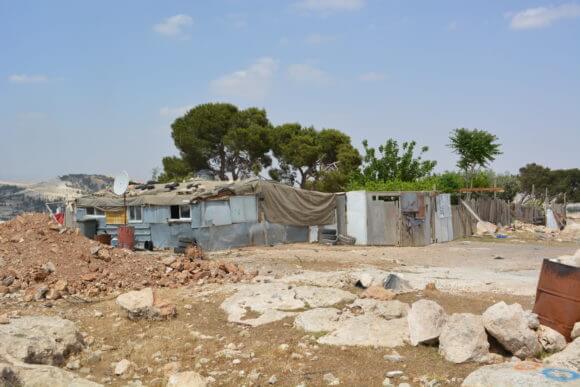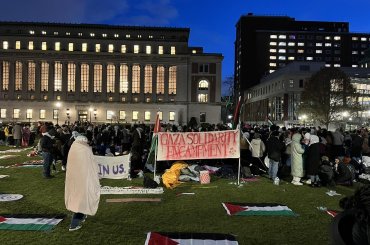Forty-two-year-old Atallah Mazara’a from the Jahalin Bedouin tribe recalls a time when residents were free to move, unhindered by concrete walls and unobtainable permits.
“Life was so simple before the [separation barrier] because you could leave for vacation, for weddings; you could take your car and go to Jerusalem,” Mazara’a said.
“You could pray Maghrib [prayer just after sunset] here and then pray Isha [evening prayer] at al-Aqsa.”
Such a scenario today remains a distant dream for the Bedouins living at Jabal al-Baba, also known as Pope Mountain, even though Jerusalem is only 2.5 miles away. Now, Bedouin communities stand in the way of the E1 zone, which would expand settlements from Ma’ale Adumim to occupied East Jerusalem.

They have been living under a blockade, with their confines increasingly shrinking, Mazara’a explained, as he showed a map of the encircling separation barrier from his office. When completed, the separation barrier will surround the community on all three sides, cutting them off even from the neighboring town of Eizariya.
“Everything is closed off… we have only one entrance and the [Israeli forces] are going to close it. They already close it from time to time, so we’re kind of used to it,” Mazara’a said, noting last week’s closure when they held demonstrations in support of Palestinian hunger-striking detainees.
“Since the blockade, we’ve been limited. There aren’t a lot of things to do; everything has been reduced. There’s no place to work; we’ve only worked with sheep.”
The Jahalin Bedouins had a stable life, herding over 2,000 sheep but the number has now dwindled to just about 400 following Israel’s occupation of the West Bank in 1967, which cut access to their grazing grounds.
Jerusalem is no longer accessible to sell their meat and dairy products like they had done in the past. No longer able to produce and trade for a livelihood, most of the Bedouin now work in the settlements or take up jobs in construction.
Now they’re about to lose the little land that they have left since their homes stand in the way of the E1 corridor, an area of 4.6 square miles that would create an urban block from the illegal West Bank settlement of Ma’ale Adumim to occupied East Jerusalem.
Israeli authorities seek to relocate 18 Bedouin communities that live in E1 and a total of 46 Bedouin communities living in the central West Bank.
Fifty-six families at Jabal al-Baba face imminent demolitions of their homes. Last year, 48 homes were destroyed, but the Bedouins rebuild their homes as soon as the Israeli forces leave. It’s been like this for five, six years, Mazara’a explained.
Israel says they’re relocating the Bedouins because the tents and shacks that they built are on state land and are illegal, since they don’t have the required permits. However, it’s impossible for residents to receive permits when they don’t have a planning scheme approved by Israeli authorities, according to a report by the UN.
The Jahalin were already expelled once before in 1948 from their ancestral lands in the Negev desert to make way for Jewish communities. As displaced refugees, they settled at Jabal al-Baba in the early 1950s after contracting leases for land with Palestinian owners.
The E1 master plan first approved in 1999, covered about 4.6 square miles of land, most of which Israel declared as state land in a “legally dubious procedure” according to B’Tselem. It now is zoned as part of the Ma’ale Adumim settlement and the total area encompasses 18.5 square miles.



Jerusalem must expand to remain a Zionist city
The Bedouins say their location is Jerusalem’s “last line of defense.” If the E1 corridor is constructed, East Jerusalem will be encircled with settlements, isolating it from the rest of the West Bank, blocking any attempts of designating East Jerusalem as the capital of a future Palestinian state.
The West Bank’s north and south would also be separated, threatening the two-state solution.
In a column published in Israel Hayom, David Weinberg, director of public affairs at Bar-Ilan University’s Begin-Sadat Center for Strategic Studies and senior adviser of the Tikvah Fund in Israel wrote that building 50,000 homes on Jerusalem’s eastern edge as part of E1 is “absolutely critical” for Israel’s security and for Jerusalem’s natural growth.
“[E1] is the last significant piece of unsettled land in the Jerusalem envelope. It is the only place where tens of thousands of homes can be built in order to overcome Jerusalem’s serious housing shortage,” Weinberg wrote.
“Jerusalem must grow in order to remain a pluralistic and modern metropolitan. It must expand in order to remain a Zionist city.”
Right-wing Israeli ministers have also been pushing to adopt a bill that would annex Ma’ale Adumim to Israel proper, but the bill was postponed earlier this year due to international pressure.
Just a few days after President Donald Trump’s inauguration, Israel approved to build 600 settler homes in East Jerusalem and another 2,500 settler homes in the West Bank “in response to housing needs” according to Defense Minister Avigdor Lieberman. It is largest settlement plan announced in recent years.
In early February Israeli lawmakers also passed a bill that would retroactively legalize the expropriation of private Palestinian land.
“We will do anything to stay here”
At Jabal al-Baba, scraps of iron from destroyed homes pile up 6 feet high, waiting to be recycled.
Along the unpaved road, pieces of corrugated metal and wood remain scattered in areas where Bedouin homes once stood. EU logos featured on some of the metal caravans are no deterrence for bulldozers.
Baghdad Fataftah, a young volunteer from Hebron points to a destroyed white van with missing doors, windows and tires. It served as a makeshift home for Salem Jahalin after his house was demolished in late January, despite obtaining a court injunction against it.
The van’s backseats served as his bedroom and the side mirror was used as a peg for hanging clothes. He covered the van with a tarpaulin to shield himself from the rain and winter wind.
His wife and four children were sent to live with Salem’s married brother. This was the family’s second demolition since 2014. Salem was financially able to rebuild his shack after the first demolition, however this time he could only afford to try to build a shelter using car tires but failed.
“We haven’t seen him in a while; we don’t know where he’s gone,” Fataftah said.
In the first two months of 2017, 24 Bedouin structures were demolished in the E1 area compared to 85 in all of 2016.
The Jahalin launched a campaign calling on the European Union and the International Criminal Court to act. Their online petition has garnered nearly one million signatures.
“We’re always standing up for ourselves in the face of occupation,” Mazara’a said. We will do anything to stay here.
“We won’t take any offers [of relocation, financial compensation.] Our problem isn’t with religion, with Judaism; the problem is with Zionism and the occupation.
“They offered us financial support and also offered us land taken away from other Palestinians but that’s why we ‘re not agreeing with this. We won’t live on land which our own fellow Palestinians were expelled from. The only offer we would accept is if they let us return to Be’er Sheva, to our original land,” Mazara’a said.
Last month activists formed a 30 by 100-yard long message on a slope using 10,000 rocks that read: “We shall remain” in Arabic. A few hours later, Israeli forces returned and destroyed it, but the activists have already rebuilt it twice.
From his home on the mountainous terrain of Jabal al-Baba, Mazara’a is calling out to the world to help.
“What’s happening here and having this [separation] wall is what gives us the strength and the will to defend our land,” Mazara’a said.
“I want to send a message to the world that you should pay attention to what is going on here and break the silence. If you can, boycott Israel,” Mazara’a said.



Wow, how sad. Thank you for sharing this report. It breaks my heart, but you cannot break the human spirit.
In Jemna in 2011 in Tunisia the peasants seized back their date groves stolen by the French in 1912 and then nationalised after independence, you may find these interesting,
“we are no longer under the tutelage of the state”
http://www.tlaxcala-int.org/article.asp?reference=19303
https://www.pambazuka.org/land-environment/jemna-tunisia-inspiring-land-struggle-north-africa
Look on the bright side. Ethnic cleansing is currently not necessary, so they are just doing this to stay in practice. Let us hold our noses and primarily celebrate.
geez….